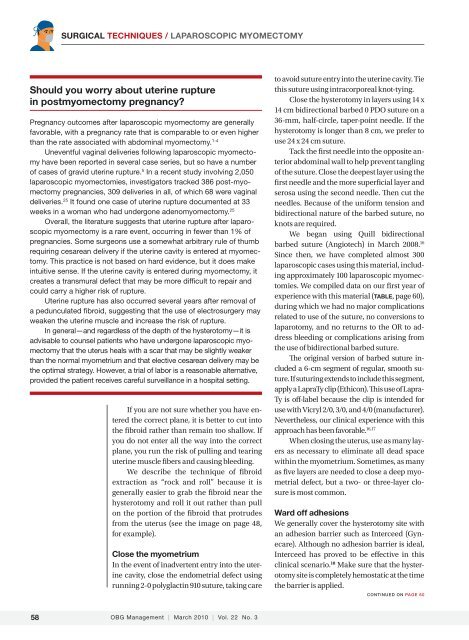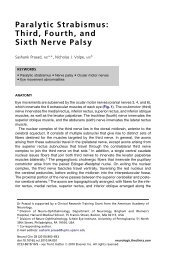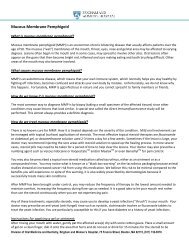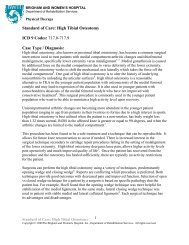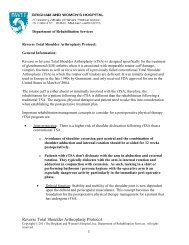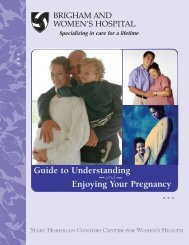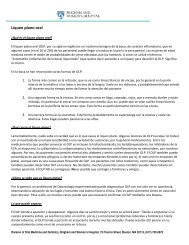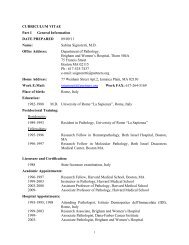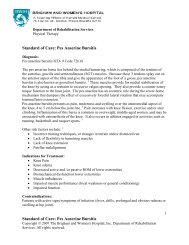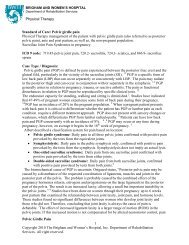Laparoscopic Myomectomy - Brigham and Women's Hospital
Laparoscopic Myomectomy - Brigham and Women's Hospital
Laparoscopic Myomectomy - Brigham and Women's Hospital
Create successful ePaper yourself
Turn your PDF publications into a flip-book with our unique Google optimized e-Paper software.
SURGICAL TECHNIQUES / LAPAROSCOPIC MYOMECTOMY<br />
Should you worry about uterine rupture<br />
in postmyomectomy pregnancy?<br />
Pregnancy outcomes after laparoscopic myomectomy are generally<br />
favorable, with a pregnancy rate that is comparable to or even higher<br />
than the rate associated with abdominal myomectomy. 1-4<br />
Uneventful vaginal deliveries following laparoscopic myomectomy<br />
have been reported in several case series, but so have a number<br />
of cases of gravid uterine rupture. 5 In a recent study involving 2,050<br />
laparoscopic myomectomies, investigators tracked 386 post-myomectomy<br />
pregnancies, 309 deliveries in all, of which 68 were vaginal<br />
deliveries. 25 It found one case of uterine rupture documented at 33<br />
weeks in a woman who had undergone adenomyomectomy. 25<br />
Overall, the literature suggests that uterine rupture after laparoscopic<br />
myomectomy is a rare event, occurring in fewer than 1% of<br />
pregnancies. Some surgeons use a somewhat arbitrary rule of thumb<br />
requiring cesarean delivery if the uterine cavity is entered at myomectomy.<br />
This practice is not based on hard evidence, but it does make<br />
intuitive sense. If the uterine cavity is entered during myomectomy, it<br />
creates a transmural defect that may be more difficult to repair <strong>and</strong><br />
could carry a higher risk of rupture.<br />
Uterine rupture has also occurred several years after removal of<br />
a pedunculated fibroid, suggesting that the use of electrosurgery may<br />
weaken the uterine muscle <strong>and</strong> increase the risk of rupture.<br />
In general—<strong>and</strong> regardless of the depth of the hysterotomy—it is<br />
advisable to counsel patients who have undergone laparoscopic myomectomy<br />
that the uterus heals with a scar that may be slightly weaker<br />
than the normal myometrium <strong>and</strong> that elective cesarean delivery may be<br />
the optimal strategy. However, a trial of labor is a reasonable alternative,<br />
provided the patient receives careful surveillance in a hospital setting.<br />
58<br />
If you are not sure whether you have entered<br />
the correct plane, it is better to cut into<br />
the fibroid rather than remain too shallow. If<br />
you do not enter all the way into the correct<br />
plane, you run the risk of pulling <strong>and</strong> tearing<br />
uterine muscle fibers <strong>and</strong> causing bleeding.<br />
We describe the technique of fibroid<br />
extraction as “rock <strong>and</strong> roll” because it is<br />
generally easier to grab the fibroid near the<br />
hysterotomy <strong>and</strong> roll it out rather than pull<br />
on the portion of the fibroid that protrudes<br />
from the uterus (see the image on page 48,<br />
for example).<br />
Close the myometrium<br />
In the event of inadvertent entry into the uterine<br />
cavity, close the endometrial defect using<br />
running 2-0 polyglactin 910 suture, taking care<br />
58 OBG Management | March 2010 | Vol. 22 No. 3<br />
to avoid suture entry into the uterine cavity. Tie<br />
this suture using intracorporeal knot-tying.<br />
Close the hysterotomy in layers using 14 x<br />
14 cm bidirectional barbed 0 PDO suture on a<br />
36-mm, half-circle, taper-point needle. If the<br />
hysterotomy is longer than 8 cm, we prefer to<br />
use 24 x 24 cm suture.<br />
Tack the first needle into the opposite anterior<br />
abdominal wall to help prevent tangling<br />
of the suture. Close the deepest layer using the<br />
first needle <strong>and</strong> the more superficial layer <strong>and</strong><br />
serosa using the second needle. Then cut the<br />
needles. Because of the uniform tension <strong>and</strong><br />
bidirectional nature of the barbed suture, no<br />
knots are required.<br />
We began using Quill bidirectional<br />
barbed suture (Angiotech) in March 2008. 16<br />
Since then, we have completed almost 300<br />
laparoscopic cases using this material, including<br />
approximately 100 laparoscopic myomectomies.<br />
We compiled data on our first year of<br />
experience with this material (TABLE, page 60),<br />
during which we had no major complications<br />
related to use of the suture, no conversions to<br />
laparotomy, <strong>and</strong> no returns to the OR to address<br />
bleeding or complications arising from<br />
the use of bidirectional barbed suture.<br />
The original version of barbed suture included<br />
a 6-cm segment of regular, smooth suture.<br />
If suturing extends to include this segment,<br />
apply a LapraTy clip (Ethicon). This use of Lapra-<br />
Ty is off-label because the clip is intended for<br />
use with Vicryl 2/0, 3/0, <strong>and</strong> 4/0 (manufacturer).<br />
Nevertheless, our clinical experience with this<br />
approach has been favorable. 16,17<br />
When closing the uterus, use as many layers<br />
as necessary to eliminate all dead space<br />
within the myometrium. Sometimes, as many<br />
as five layers are needed to close a deep myometrial<br />
defect, but a two- or three-layer closure<br />
is most common.<br />
Ward off adhesions<br />
We generally cover the hysterotomy site with<br />
an adhesion barrier such as Interceed (Gynecare).<br />
Although no adhesion barrier is ideal,<br />
Interceed has proved to be effective in this<br />
clinical scenario. 18 Make sure that the hysterotomy<br />
site is completely hemostatic at the time<br />
the barrier is applied.<br />
CONTINUED ON PAGE 60


